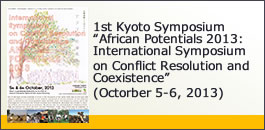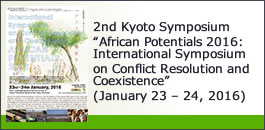Date: July 13, 2013
Venue: Inamori Foundation Memorial Bldg. (Inamori Center), Middle-sized Meeting Room, Kyoto University
Program
13:30-14:00:Business Announcement
14:00-17:40: ”South Sudan: Continuous Armed Conflicts and Potential for Coexistence”
14:00-14:15:Eisei Kurimoto (Osaka University) “Introduction: Attempt of Categorizing the Armed Conflicts after CPA (in 2005) into Patterns”
14:15-14:45: Isao Murahashi (Osaka University) “Inter-ethnic-group and Intra-group Conflicts and Potential for Coexistence: Issues in Lopit after CPA
14:45-15:15: Naoki Naito (Tokushima University) “Returnees and Peace Building: a Case of L Village in Torit County, Eastern Equatoria State”
15:15-15:45: Eri Hashimoto (Hitotsubashi University) “Roles of Prophets in Armed Conflicts: A Case from Jonglei State in Post-independence South Sudan”
15:45-16:00: Break
16:00-16:30: Akira Okazaki (Hitotsubashi University) “New Armed Conflicts in ‘New Southern Sudan’”
16:30-17:00: Eisei Kurimoto (Osaka University) “Limit and Potential for Grassroots Peace Building”
17:00-17:40: General Discussion
Overview
Eisei Kurimoto
Introduction: Attempt of Ccategorizing the Armed Conflicts after CPA (in 2005) into Patterns
The speaker attempted to present a chronology of the course after the Comprehensive Peace Agreement (CPA), as well as to categorize the conflicts according to the actors (eight groups, namely, SPLA, SAF, UNMISS, the pro-Sudanese government militia, the rebels, LRA, unknown armed groups and civil/ethnic groups). Nuer people could not help themselves but become bellicose in the 1910s.
Isao Murahashi
Inter-ethnic-group and Intra-group Conflicts and Potential for Coexistence: Issues in Lopit after CPA
The speaker first explained livelihoods, political systems (age-grade and chieftain system) in agrarian societies of the Lopit, an Eastern Nilotic ethnic group living in South Sudan, their refuge to neighboring countries and other areas in the country during the civil wars (First and Second Sudan Civil Wars) and their situation in becoming refugees, the reconciliation conference and return of cattle, and moves towards self-defense. He discussed inter-group conflicts, including cattle raiding and child kidnapping, antagonism between communities in the group, land disputes and murder cases. Confrontations between communities have not declined in the period after CPA, and even cattle raiding, which is seemingly “traditional”, illustrates the deteriorating of the relationship during or after the civil war which resulted in the repeated attacks and retaliations. With disarmament in local communities being sluggish, the violence has increased. Presumably, the government’s sluggish engagement for improvement of living, accelerated movement towards independence of ethnic groups and their conflicts and separation lie in the background to these circumstances.
Naoki Naito
Returnees and Peace Building: A Case of L Village in Torit County, Eastern Equatoria State
In post-conflict societies, including South Sudan, conflicts and human rights abuse intermittently occur. For this reason, situations such as prolonged status as a refugee and/or displaced, or returnees becoming refugees again or becoming internally displaced persons, or little progress in return of refugees and/or displaced people often arise. Therefore, support for reintegration of these involuntary immigrants, including refugees, internally displaced persons and returnees into a society is important. However in South Sudan, he pointed out that the risk of a profound impact on the lives of residents in the local society is high as a result of land-grabbing by foreign companies. With a focus on the involuntary immigrants in Lotuho society in the Eastern Equatoria State and their efforts to reconstruct their lives by proactively approaching various actors, he showed the future studies which would evaluate their act as a grassroots practice for peace building and community development. The village needs a public square and a pillar is erected in the square. Sorghum is important in their rituals as it represents fertility and wealth of life. They suffered from poor harvest of sorghum in 2009 and 2010 due to the effects of drought. It was suggested that the people not only engage in farming, but they also combine fishing, gathering, animal husbandry such as cattle keeping, employment, pensions and brewing, and transferred money from residents in urban areas as well as utilizing the traditional mutual support system. On the other hand, the presentation also reported the current situation where migrant labor, from neighboring Kenya and Uganda, who came to the country counting on the economic boom for reconstruction and obtainment and development of farmland by major forces.
Eri Hashimoto
Roles of Prophets in Armed Conflicts: A Case from Jonglei State in Post-independence South Sudan
Hashimoto discussed the roles of Nuer prophets during armed conflicts in Jonglei state which occurred after independence. For the Nuer people, prophets have been traditionally seen as an existence which launches attacks traditionally at the same time as playing a role as a conflict mediator. However, they were put under oppression during the colonial era as they were seen as leading the resistance movement. After the independence of South Sudan, a person called Dack Ques appeared as a prophet in the midst of frequent conflicts between ethnic groups. He is said to have performed several miracles in the past, but he especially gained a high reputation as a prophet beyond the communities after foretelling an attack from the neighboring Murle people in August 2011. During the attack of the Low Nuer on the Mursi from late 2011 to 2012, between 6,000 and 8,000 people of the Nuer White Army were mobilized for battle and the media reported that they were led by Dack. However, according to an interview conducted by Hashimoto, it was not Dack himself who led the attack, but he only played an additional and limited role such as providing information on his prophecy to the front-line by phone. When he got arrested on a later day, people in the region gave him a negative evaluation by calling him “witch”, but he came to be seen as a “prophet” who did a righteous act when people’s distrust of the government was reinforced with the disarmament policy implemented soon afterwards. Additionally, people refer to the foretelling of Ngunden, who was a prominent prophet in the 19th century when they explain their present relationship with Murle, and they came to speak of Dack as an existence which appeared in order to pursue the prophecy of Ngunden. In this way, prophecy serves as a medium to connect the past and present, as well as enemies and friends among the Nuer today, and the people identify and share the causes of conflicts through the language of the prophet. In the Q and A session, issues were discussed which included: in which part of this case study of prophet one can find “Nuer-ness”; whether the evaluation of Dack’s role in conflict being “additional” is reasonable; and why the people in the White Army sought the advice of the prophet who was not there in the battlefield.
Akira Okazaki
New Armed Conflicts in ‘New Southern Sudan’
Okazaki elucidated the new phase of conflicts in ‘new southern Sudan’, in other words, southern Sudan which was formed after the independence of South Sudan. New southern Sudan as a region is originally a name derived from SPLA-North (Sudan People’s Liberation Army-North), which consisted of the people from the Nuba mountains in Blue Nile and South Kordofan, but later SRF (Sudan Revolutionary Front) was formed by merging the movements of people in the Darfur states. Although this region was fertile land and has been available for rain fed agriculture, people have experienced discrimination in employment, education and day-to-day lives while the government has installed large scale farms with funding from the World Bank and other institutions and has seized the interests of resources including oil. For this reason, people in this region joined SPLA and fought with the people in the south, but they continued their own battles separately from South Sudan after CPA in 2005. Airstrikes in the Blue Nile region by the Sudanese government started in September 1st, 2011 and this led the regional residents to become refugees in Ethiopia and South Sudan. The background to the continued expulsion of the people in the new southern Sudan lies in the fact that the regime in Sudan, which has been increasingly Islam/Arab centric since the independence of South Sudan, identifies the people in the region as “internal others”. The oil pipeline between Sudan and South Sudan was re-closed in June 2013. The Sudanese government pointed out that “South Sudan is supporting the anti-government force in new south Sudan” as one of the reasons for the closure, but its evidence is weak. With oil revenue being important for both governments in south and north, it can be said that the treatment of the new southern Sudan would determine the fate of the relationship between the two countries. Although the independence of South Sudan concurrently means that Sudan must restart as a new country, new constitutional revision has yet to be taken up in both countries in reality. In contrast, anti-government forces and others in the new southern Sudan have created an innovative constitution draft based on pluralism. At the end of the presentation, Okazaki developed the discussion into issues based around the word “potential” and raised questions such as: intervention by the international community in a conflict may be constricting the mark of “potential of Africa” by sustaining the situation in the air; who knows the “potential”; weather it would not be a problem if such recognition as “external researchers are the ones who know it” existed; how we should understand the paternalistic position which appears when a word “utilizing” is associated with “potential” while one has no other way but to utilize the potential which has originally been there; and whether we can regard as “potential” the attitude of the present Sudanese government which has maintained its regime despite of international criticism.
Eisei Kurimoto
Limit and Potential for Grassroots Peace Conference
At the beginning, Kurimoto pointed out that in terms of information from the news on armed conflicts, one cannot always understand the details of “who” was mobilized in the first place, and such information is often full of vague issues politically, socially and medically, and that media coverage often diminishes the historical context of the conflicts happening today. A countless number of grassroots peace building conferences have been organized in South Sudan since the time of the civil wars. Although there have been successful examples such as the Akobo conference in 1994 and Unrit conference in 1999, many of the articles which had been agreed in the conferences were not implemented in later days. The reasons for them need to be discussed. On the other hand, with the number of opportunities to organize grassroots peace building conference itself declining after CPA in 2005, it is a problem that there has been an abundance of war-torn societies in the period after the civil wars. Also, the government needs to take a role in adopting a “peace from the top” in an appropriate manner as the grassroots peace building has its limitations, yet the role has not been played by the government since 2005. The Pari, the Lopit and the Lotuho peoples who live in the research field in which Kurimoto has conducted studies for a long time has indicated a significant decline in the flow of the people compared to before the outbreak of the civil war, but it has not completely ceased even until today. Cross-cutting tiess were at work even in the period of the civil wars, and it was extremely important for people’s survival. Relationships like this can guarantee people’s convenience in day-to-day lives and thus a relationship among the people which is orientated towards coexistence can be considered as regional “potential”.
General Discussion
In the general discussion, the theme setting for the international workshop in Juba scheduled for this fiscal year was discussed. Kurimoto stated that he would like to have discussions centered on the following two issues: 1) How to evaluate the interventions which have been conducted in the name of “peace building” since the time of the civil wars; and 2) What kind of peace-building initiatives which have been developed inside communities are found today. Also, the discussion pointed out that even some elements that are seen as negative components for “peace building” in today’s political-economic situation have aspects which may turn into positive elements for the stabilization of the region in a mid- to long-term perspective. Thus there was a shared understanding that the contents of “potential” may vary according to the time span.
(Shuichi Oyama and Toru Sagawa)
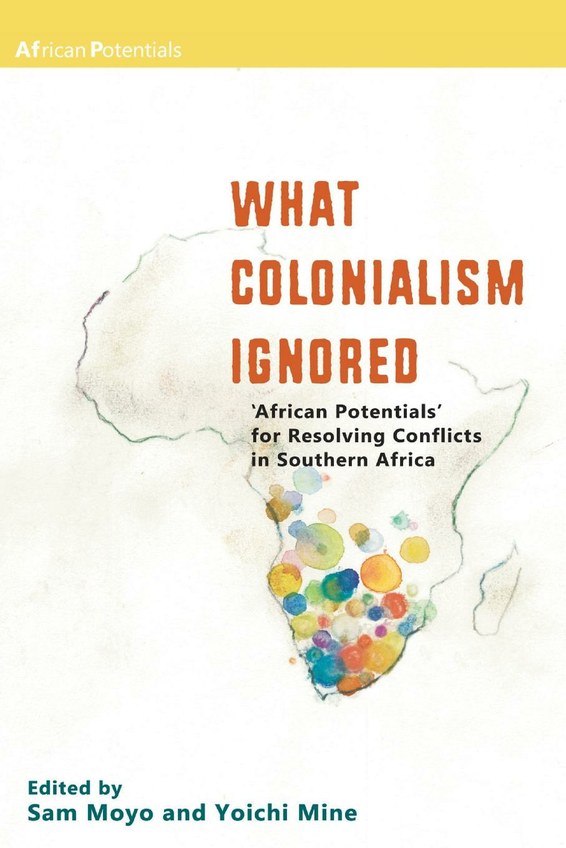
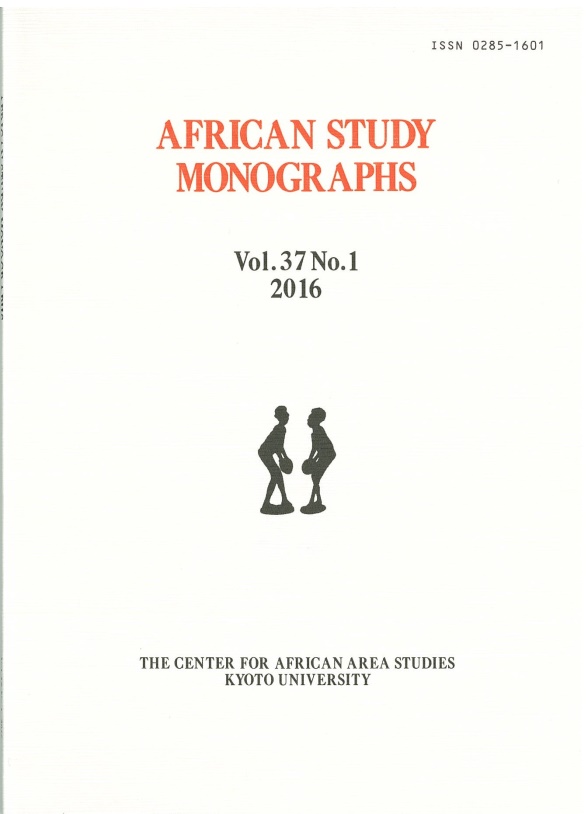
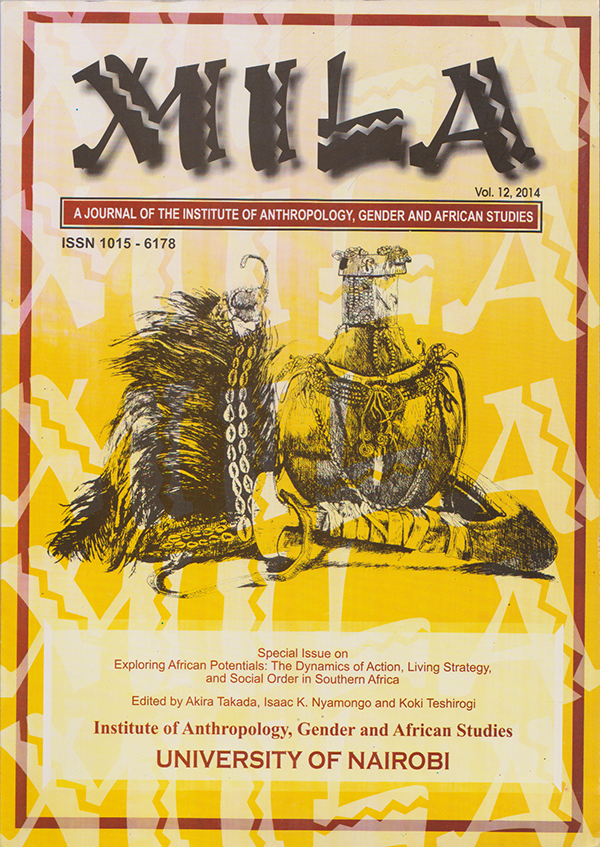 Exploring African Potentials, Mila Special Issue
Exploring African Potentials, Mila Special Issue